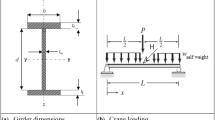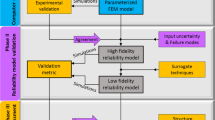Abstract
In this paper, the structural reliability and sensitivity of bridge crane have analyzed and calculated. A comprehensive evaluation framework of structural reliability and global sensitivity of bridge crane under two dangerous conditions and multiple uncertain factors is proposed. In order to simulate the typical failure modes under two dangerous conditions, the calculation is based on the high fidelity finite element model (FEM) of bridge crane. For calculation methods, the framework includes: high-precision Monte Carlo simulation (MCS) scheme for verification and high-efficiency artificial neural network (ANN)-based scheme for application. The reliability results show that the accuracy of the calculation results based on artificial neural network is acceptable (the relative errors are −0.86 %, −10 %, 5.26 % and 0, respectively), and 85 % of the calculation time is saved. The results show uncertain parameters related to loads, section size and elastic modulus should be paid attention to in bridge crane structural reliability design.
Similar content being viewed by others
References
Y. Zheng, F. Zhao and Z. Wang, Fault diagnosis system of bridge crane equipment based on fault tree and Bayesian network, Int. J. Adv. Manuf. Technol., 105(9) (2019) 3605–3618.
H. Lei et al., Creep/fatigue accelerated failure of Ni-based superalloy turbine blade: microscopic characteristics and void migration mechanism, Int. J. Fatigue., 154 (2022) 106558.
L. Cheng et al., Moving extremum surrogate modeling strategy for dynamic reliability estimation of turbine blisk with multiphysics fields, Aerosp. Sci. Technol., 106 (2020) 106112.
L. Cheng et al., Probabilistic analyses of structural dynamic response with modified Kriging-based moving extremum framework, Eng. Fail. Anal., 125 (2021) 105398.
C. W. Fei et al., Multilevel nested reliability-based design optimization with hybrid intelligent regression for operating assembly relationship, Aerosp. Sci. Technol., 103 (2020) 105906.
R. G. Yang et al., Load reduction test method of similarity theory and BP neural networks of large cranes, Chin. J. Mech. Eng., 29(1) (2015) 145–151.
W. Li et al., A comprehensive framework for model validation and reliability assessment of container crane structures, Struct. Multidiscip. Optim., 62(5) (2020) 2817–2832.
R. G. Yang et al., Interval non-probabilistic time-dependent reliability analysis of boom crane structures, J. Mech. Sci. Technol., 35(2) (2020) 535–544.
A. Der Kiureghian and T. Dakessian, Multiple design points in first and second-order reliability, Struct. Saf., 20 (1998) 37–49.
M. Philippe, A first order reliability method for series systems, Struct. Saf., 22(1) (2000) 5–16.
M. A. Shayanfar, M. A. Barkhordari and M. A. Roudak, A new effective approach for computation of reliability index in nonlinear problems of reliability analysis, Commun. Nonlinear. Sci. Numer. Simul., 60 (2018) 184–202.
D. X. Yang, Chaos control for numerical instability of first order reliability method, Commun. Nonlinear. Sci. Numer. Simul., 15(10) (2010) 3131–3141.
Y. T. Wang et al., A confidence-based reliability optimization with single loop strategy and second-order reliability method, Comput. Methods. Appl. Mech. Engrg., 372 (2020) 113436.
W. Zhao et al., An effective first order reliability method based on Barzilai-Borwein step, Appl. Math. Model., 77(2) (2020) 1545–1563.
B. Keshtegar and Z. Meng, A hybrid relaxed first-order reliability method for efficient structural reliability analysis, Struct. Saf., 66 (2017) 84–93.
C. Wang, H. Zhang and Q. W. Li, Moment-based evaluation of structural reliability, Eliab. Eng. Syst. Safe., 181 (2018) 38–45.
S. X. Guo, An efficient third-moment saddlepoint approximation for probabilistic uncertainty analysis and reliability evaluation of structures, Appl. Math. Model., 28(3) (2006) 261–272.
Z. H. Lu, D. Z. Hu and Y. G. Zhao, Second-order fourth-moment method for structural reliability, J. Eng. Mech., 143 (4) (2017).
T. Zhang, An improved high-moment method for reliability analysis, Struct. Multidiscip. Optim., 56 (2017) 1225–1232.
H. Lu et al., An improved high order moment-based saddlepoint approximation method for reliability analysis, Appl. Math. Model., 82 (2020) 836–847.
A. Delbariani-Nejad and S. A. Nazari, Effects of loading modes on reliability of cracked structures using FORM and MCS, Int. J. Precis. Eng. Manuf., 18(1) (2017) 63–76.
X. Zhai et al., A stochastic model updating strategy-based improved response surface model and advanced Monte Carlo simulation, Mech. Syst. Signal. Proc., 82 (2017) 323–338.
V. Dubourg, B. Sudret and F. Deheeger, Metamodel-based importance sampling for structural reliability analysis, Probabilist. Eng. Mech., 33 (2013) 47–57.
I. Papaioannou, C. Papadimitriou and D. Straub, Sequential importance sampling for structural reliability analysis, Struct. Saf., 62 (2016) 66–75.
K. M. Zuev et al., Bayesian post-processor and other enhancements of subset simulation for estimating failure probabilities in high dimensions, Comput. Struct., 92–93 (2012) 283–296.
H. S. Li and S. K. Au, Design optimization using subset simulation algorithm, Struct. Saf., 32(6) (2010) 384–392.
X. X. Huang, J. Q. Chen and H. P. Zhu, Assessing small failure probabilities by AK-SS: an active learning method combining Kriging and subset simulation, Struct. Saf., 59 (2016) 86–95.
T. X. Zhang, Y. M. Zhang and X. P. Du, Reliability analysis for k-out-of-n systems with shared load and dependent components, Struct. Multidiscip. Optim., 57(3) (2018) 913–923.
C. W. Fei et al., Enhanced network learning model with intelligent operator for the motion reliability evaluation of flexible mechanism, Aerosp. Sci. Technol. (2020) 107.
B. Echard, N. Gayton and M. Lemaire, AK-MCS: an active learning reliability method combining Kriging and Monte Carlo simulation, Struct. Saf., 33(2) (2011) 145–154.
C. W. Fei, C. Lu and R. P. Liem, Decomposed-coordinated surrogate modeling strategy for compound function approximation in a turbine-blisk reliability evaluation, Aerosp. Sci. Technol (2019) 95.
C. Lu et al., Probabilistic analyses of structural dynamic response with modified Kriging-based moving extremum framework, Eng. Fail. Anal. (2021) 125.
R. B. Solanki et al., Reliability assessment of passive systems using artificial neural network based response surface methodology, Ann. Nucl. Energy, 144 (2020) 107487.
M. Rashki et al., Classification correction of polynomial response surface methods for accurate reliability estimation, Struct. Saf. (2019) 81.
L. K. Song et al., Dynamic neural network method-based improved PSO and BR algorithms for transient probabilistic analysis of flexible mechanism, Adv. Eng. Inform., 33 (2017) 144–153.
D. Lehký and M. Šomodíková, Reliability calculation of time-consuming problems using a small-sample artificial neural network-based response surface method, Neural. Comput. and Applic., 28 (2017) 1249–1263.
Y. Zhou et al., Surrogate modeling of high-dimensional problems via data-driven polynomial chaos expansions and sparse partial least square, Comput. Method. Appl. M. (2020) 364.
L. X. Zheng et al., An active learning method combining deep neural network and weighted sampling for structural reliability analysis, Mech Syst Signal Pr, 140 (2020) 106684.
M. R. Rajashekhar and B. R. Ellingwood, A new look at the response surface approach for reliability analysis, Struct. Saf., 12(3) (1993) 205–220.
C. Y. Zhang et al., Advanced multiple response surface method of sensitivity analysis for turbine blisk reliability with multi-physics coupling, Appl. Math. Mech., 29(4) (2007) 962–971.
S. N. Xiao and Z. Z. Lu, Structural reliability sensitivity analysis based on classification of model output, Aerosp. Sci. Technol., 71 (2017) 52–61.
I. M. Sobol, Global sensitivity indices for nonlinear mathematical models and their Monte Carlo estimates, Math. Comput. Simulat., 55 (2001) 221–280.
L. Y. Li et al., Moment-independent importance measure of basic variable and its state dependent parameter solution, Struct. Saf., 38 (2012) 40–47.
GBT3811-2008 Design Rules for Cranes, China Standards Press, Beijing (2008) (in Chinese).
R. M. Nejad et al., Failure analysis of a working roll under the influence of the stress field due to hot rolling process, J. Fail Fail Anal Prev. (2021) 1–10.
K. Alilakbari, M. Imanparast and R. Masoudi Nejad, Microstructure and fatigue fracture mechanism for a heavy-duty truck diesel engine crankshaft, Sci. Iran, 26(6) (2019) 3313–3324.
K. Aliakbari et al., Analysis of stress intensity factors in railway wheel under the influence of stress field due to heat treatment and press-fitting process, Eng. Fail Anal., 130 (2021) 105736.
E. Borgonovo, A new uncertainty importance measure, Eliab. Eng. Syst. Safe., 92 (2007) 771–784.
A. Saltelli, S. Tarantola and F. Campolongo, Sensitivity analysis as an ingredient of modeling, Stat. Sci., 19(4) (2000) 377–395.
L. J. Cui, Z. Z. Lu and X. P. Zhao, Moment-independent importance measure of basic random variable and its probability density evolution solution, Sci. China. Tech. Sci., 53(4) (2010) 1138–1145.
C. C. Zhou et al., Reliability and global sensitivity analysis for an airplane slat mechanism considering wear degradation, Chinese. J. Aeronaut., 34(1) (2021) 163–170.
H. G. Zhang, Z. S. Wang and D. R. Liu, A comprehensive review of stability analysis of continuous-time recurrent neural networks, IEEE. Trans. Neural. Netw. Learn. Syst., 7(25) (2014) 1229–1262.
L. Liu, Z. S. Wang and H. G. Zhang, Adaptive fault-tolerant tracking control for MIMO discrete-time systems via reinforcement learning algorithm with less learning parameters, IEEE. Trans. Autom. Sci. Eng., 14(1) (2017) 299–313.
A. A. Chojaczyk et al., Review and application of artificial neural networks models in reliability analysis of steel structures, Struct. Saf., 52(Part A) (2015) 78–89.
A. H. Elhewy, E. Mesbahi and Y. Pu, Reliability analysis of structure using neural network method, Probab. Eng. Mech., 21(1) (2006) 44–53.
Acknowledgments
This work was sponsored by the Fund for National Natural Science Foundation of China (51805348), sponsored by the Fund for Shanxi “1331 Project” Key Subjects Construction.
Author information
Authors and Affiliations
Corresponding author
Additional information
Yang Ruigang received the B.S. degree in Mechanical Engineering from Taiyuan University of Technology in 1998 and the Ph.D. degree in Mechanical Engineering from Taiyuan University of Technology in 2009. He is a Professor of Taiyuan University of Science and Technology of China. He has published more than 50 journal articles and conference papers.
Rights and permissions
About this article
Cite this article
Li, W., Yang, R., Qi, Q. et al. Reliability and sensitivity analysis of bridge crane structure. J Mech Sci Technol 36, 4419–4431 (2022). https://doi.org/10.1007/s12206-022-0807-1
Received:
Revised:
Accepted:
Published:
Issue Date:
DOI: https://doi.org/10.1007/s12206-022-0807-1




